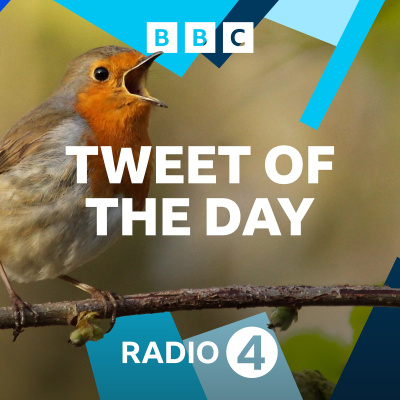Sinopsis
Discover birds through their songs and calls. Each Tweet of the Day begins with a call or song, followed by a story of fascinating ornithology inspired by the sound.
Episodios
-
Snow Goose
21/03/2014 Duración: 01minTweet of the Day is a series of fascinating stories about our British birds inspired by their calls and songs. Bill Oddie presents the snow goose. Snow geese breed in the Canadian Arctic and fly south in autumn to feed. Their migrations are eagerly awaited and the arrival of thousands of these white geese with black-wingtips is one of the world’s great wildlife spectacles. Here, on the opposite side of the Atlantic, snow geese are seen every year, often with flocks of other species such as white-fronted geese. Snow geese are commonly kept in captivity in the UK, and escaped birds can and do breed in the wild. So, when a white shape turns up amongst a flock of wild grey geese, its origins are always under scrutiny.
-
Goldeneye
20/03/2014 Duración: 01minTweet of the Day is a series of fascinating stories about our British birds inspired by their calls and songs. Bill Oddie presents the goldeneye. Although they’re a common winter visitor, you’ll need to travel to Speyside in the Scottish Highlands to see goldeneyes in their breeding season where, since 1970, a small population has bred there. Unlike dabbling ducks, such as mallard and teal, they don’t need muddy shorelines and lots of vegetation. Goldeneyes are diving ducks that feed mainly on shellfish and crustaceans.
-
Sand Martin
19/03/2014 Duración: 01minBill Oddie presents the sand martin. The flickering shapes of sand martins over a lake or reservoir are a welcome sign of spring. After winging their way across the Sahara Desert, the first birds usually arrive in the UK in March. They're smaller than house martins or swallows, and they're brown above and white below with a brown band across their chest. Often you can hear their dry buzzing calls overhead before you see them.Producer: Sarah Pitt
-
Great Crested Grebe
18/03/2014 Duración: 01minTweet of the Day is a series of fascinating stories about our British birds inspired by their calls and songs. Bill Oddie presents the great crested grebe. In Spring, great crested grebes perform a high ritualized mating display. This includes head shaking and a spectacular performance during which both male and female birds gather bunches of waterweed and as they swim towards each other, before rising vertically in the water, chest to chest, and paddling furiously to keep themselves upright.
-
Grey Partridge
17/03/2014 Duración: 01minTweet of the Day is a series of fascinating stories about our British birds inspired by their calls and songs. Bill Oddie presents the Grey partridge. The grey partridge, a plump game bird, is now a rarity across most of the UK. Found on farmland, a partridge pair will often hold territory in a few fields beyond which they seldom stray during their whole lives. They should be doing well but increasing field sizes, which reduce nesting cover and the use of pesticides, which kill off vital insects, have taken their toll.
-
Woodlark
14/03/2014 Duración: 01minTweet of the Day is a series of fascinating stories about our British birds inspired by their calls and songs. Bill Oddie presents the woodlark. Woodlarks are closely related to skylarks, but they're much rarer in the UK, where they’re mainly confined, as breeding birds, to southern England. Unlike the skylark, the male woodlark will sing from trees but his piece de resistance is the song-flight in which he flies slowly in a broad loop, often very high above his territory.
-
Cetti's Warbler
13/03/2014 Duración: 01minTweet of the Day is a series of fascinating stories about our British birds inspired by their calls and songs.Bill Oddie presents the Cetti's warbler. Until the 1960s, Cetti's warblers were unknown in the UK but on the Continent they were common in marshy areas, especially dense scrub and the edge of reed-beds and ditches. They first bred in these habitats in south-east England in the early 1970s and by the end of the century their loud and sudden song-bursts were startling people from southern England and South Wales and northwards as far as Yorkshire.
-
Rook
12/03/2014 Duración: 01minTweet of the Day is a series of fascinating stories about our British birds inspired by their calls and songs.Bill Oddie presents the rook. High in the treetops buffeted by March winds, rooks are gathering twigs to build their untidy nests. The bustle of a rookery is one of the classic sounds of the UK countryside, especially in farming areas, where rooks are in their element, probing the pastures and ploughed fields with long pickaxe bills.
-
Peregrine
11/03/2014 Duración: 01minTweet of the Day is a series of fascinating stories about our British birds inspired by their calls and songs. Bill Oddie presents the peregrine. The peregrine is a truly awesome predator and a bird that we associate with wild places where, with wings flickering like knife-blades, it chases its prey in thrilling pursuits and breath-taking dives. Our city churches, cathedrals and other tall buildings are a perfect substitute for cliffs and quarries where they like to nest and with a plentiful supply of town pigeons they’re thriving in these artificial eyries.
-
Treecreeper
10/03/2014 Duración: 01minTweet of the Day is a series of fascinating stories about our British birds inspired by their calls and songs.Bill Oddie presents the treecreeper. Treecreepers are common woodland birds but because their high-pitched almost whispering song, is often drowned out by the dawn chorus, they're often overlooked. The first glimpse may be a silhouette, its belly close to the bark, braced by stiff tail feathers. It has a curved, tweezer-like bill with with which it delicately probes for hidden insects and spiders deep in the crevices of the bark.
-
Nuthatch
07/03/2014 Duración: 01minTweet of the Day is a series of fascinating stories about our British birds inspired by their calls and songs.Bill Oddie presents the nuthatch. Nuthatches are the only UK birds that can climb down a tree as fast they can go up and you'll often see them descending a trunk or hanging beneath a branch. Nuthatches are unmistakable: blue-grey above, chestnut under the tail and with a black highwayman's mask.
-
Lapwing
06/03/2014 Duración: 01minTweet of the Day is a series of fascinating stories about our British birds inspired by their calls and songs.Bill Oddie presents the lapwing. The lovely iridescent greens and purples of the lapwing: with its delicate crest and broad rounded wings that almost seem to twinkle in level flight, they are seen less often on our farmland today. At one time they were so common that their freckled eggs were harvested and sent off to the cities to pamper the palates of urban epicures.
-
Chiffchaff
05/03/2014 Duración: 01minTweet of the Day is a series of fascinating stories about the British birds inspired by their calls and songs.Bill Oddie presents the chiffchaff. Chiffchaff are small olive warblers which sing their name as they flit around hunting for insects in woods, marshes and scrubby places. Chiffchaffs are increasing in the UK and the secret of their success is their ability to weather our winters. Many stay in the milder south and south-west of England where the insects are more active.Producer Sarah Pitt
-
Blackbird (Spring)
04/03/2014 Duración: 01minTweet of the Day is a series of fascinating stories about our British birds inspired by their calls and songs.Bill Oddie presents the blackbird. Blackbirds are thrushes and the brown female often has a few speckles on her throat to prove it. Velvety, black and shiny, the males sport an eye-ring as yellow as a spring daffodil and a bill glowing like a buttercup. Happily blackbirds aren't doing too badly. There's so many of them that their territories often overlap so that where one song leaves off, another song begins.
-
St Kilda Wren
03/03/2014 Duración: 01minTweet of the Day is a series of fascinating stories about our British birds inspired by their calls and songs. Bill Oddie presents the St Kilda wren. The Island of St Kilda is not where you'd expect to see wrens but the wrens that sing along the cliffs of St Kilda are the same species as the common wren, but after 5000 years of isolation they've evolved a different song and are slightly larger and slightly paler than the mainland wrens. Bill Oddie remembers an encounter with the St Kilda Wren.
-
Wigeon
28/02/2014 Duración: 01minTweet of the Day is a series of fascinating stories about our British birds inspired by their calls and songs.John Aitchison presents the wigeon. Wigeon are dabbling ducks and related to mallards and teal but unlike these birds Wigeon spend much of their time out of the water grazing waterside pastures with their short blue-grey bills. The drakes are handsome-looking birds with chestnut heads and a cream forehead which contrasts well with their pale grey bodies.John Aitchison recorded a flock of wigeon, for Tweet listeners, on a pool in Norfolk where they had found a safe place to roost on an island.
-
Black-throated Diver
27/02/2014 Duración: 01minJohn Aitchison presents the black-throated diver. Black-throated divers are strong contenders for our most beautiful bird. Their breeding plumage with a neck barcoded in white, an ebony bib and a plush grey head is dramatic. The black dagger-like bill and broad lobed feet are perfect for catching and pursuing fish, which the divers bring to their chicks in nests on the shoreline of the Scottish Lochs on which they breed.Producer: Sarah Pitt
-
White-fronted Goose
26/02/2014 Duración: 01minTweet of the Day is a series of fascinating stories about our British birds inspired by their calls and songs.John Aitchison presents the white-fronted goose. Flocks of White-Fronted Geese return each year to their favourite wintering areas, the bogs and and saltmarshes of Ireland and the Severn Estuary as well as western Scotland, although smaller flocks are found elsewhere. John Aitchison recorded the musical yapping of white-fronted geese for Tweet listeners as they flew over his home in western Scotland.
-
Golden Pheasant
25/02/2014 Duración: 01minTweet of the Day is a series of fascinating stories about our British birds inspired by their calls and songs.John Aitchison presents the golden pheasant. Golden pheasants are native to the mountains of China where they live in thick bamboo forest. The males are brightly-coloured; gold and scarlet, with a long tail and a cape of black and orange which they use to woo the much duller brown females. From the late 1800's Golden Pheasants were introduced to many bird collections and shooting estates around the UK. Today the strongest colonies are in East Anglia.
-
Lesser Spotted Woodpecker
24/02/2014 Duración: 01minTweet of the Day is a series of fascinating stories about our British birds inspired by their calls and songs.John Aitchison presents the lesser spotted woodpecker. Lesser spotted woodpeckers are the smallest of our three woodpeckers and about the size of a house sparrow. They have horizontal white stripes across their backs, hence their old name of 'barred woodpecker'. The lesser spotted woodpecker is one of our most elusive birds. For most of the year it's relatively silent but in late February and March, males begin to stake out their territories in old woods and orchards by calling loudly and drumming softly.














